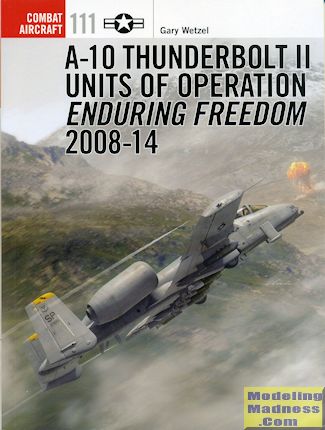 This is
basically a follow-on book on the A-10 in Afghanistan. The A-10 is one of those
planes that the Air Force has 'forced' onto it, mainly by a decision in the
1960s that did not allow offensive fixed wing aircraft in the US Army. The USAF
felt that anything with fixed wings and guns/missiles/bombs was the job of the
USAF and that the Army should stick with rotary wing for its offensive missions.
However, the Army needed a dedicated fixed wing ground attack asset so the USAF
got that job by default. The result of a requirement for this type of aircraft
was the A-10, a type that has proved itself time and time again.
This is
basically a follow-on book on the A-10 in Afghanistan. The A-10 is one of those
planes that the Air Force has 'forced' onto it, mainly by a decision in the
1960s that did not allow offensive fixed wing aircraft in the US Army. The USAF
felt that anything with fixed wings and guns/missiles/bombs was the job of the
USAF and that the Army should stick with rotary wing for its offensive missions.
However, the Army needed a dedicated fixed wing ground attack asset so the USAF
got that job by default. The result of a requirement for this type of aircraft
was the A-10, a type that has proved itself time and time again.
Several times the USAF has tried to mothball the airplane, preferring to
spend its portion of the defense budged on golf courses, pretty bases and
expensive airplanes. Every time the plane was nearly axed, our politicians got
the US involved in a war in the near east. The first time was desert storm and
the plane very much proved its worth. The second time was OEF and OIF. Again,
the A-10 proved to be very much a plane that was able to perform the mission
required.
In between DS and OE/IF, several modifications were planned for the
A-10, though put on the slow track by the USAF. One was the A-10C upgrade which
would provide a 'glass' cockpit as well as the ability to operate modern
munitions (such as the jdam) and a helmet mounted HUD, which did a lot more than
provide basic aircraft information. This system allowed the pilot to designate
targets without having to point the plane at it and also provided views from
other planes in his flight.
The ANG, which was tasked with many of the deployments, developed the
A-10+ which basically concentrated on the munitions side of things. This was
done on the relative cheap as the modification was not extensive and worked
quite well. It added capabilities while the USAF was dragging its feet on the
A-10C program.
So this book is the story of all these machinations, modifications and
the deployment of ANG/AFRES/USAF units to the fight in Afghanistan. It covers
the period from 2008 until the last A-10 unit left in 2014. As is typical of
books on modern aircraft, it is chock full of jargon and photos and some superb
pilot stories. It also has the usual raft of color profiles that Osprey aviation
books have as a sort of trademark of the series. It is an interesting read both
from an operational standpoint and to show what those who fly have to do to get
decent equipment from those who no longer do. A book that I found fascinating
and can quite easily recommend to you.
June 2015
For more on the complete line of Osprey books,
visit http://ospreygrp.com. In the US, e-mail
OspreyUSA@ospreypublishing.com, to request a catalogue of available books.
If you would like your product reviewed fairly and
fairly quickly, please
contact the editor or see other details in the
Note to
Contributors.
 This is
basically a follow-on book on the A-10 in Afghanistan. The A-10 is one of those
planes that the Air Force has 'forced' onto it, mainly by a decision in the
1960s that did not allow offensive fixed wing aircraft in the US Army. The USAF
felt that anything with fixed wings and guns/missiles/bombs was the job of the
USAF and that the Army should stick with rotary wing for its offensive missions.
However, the Army needed a dedicated fixed wing ground attack asset so the USAF
got that job by default. The result of a requirement for this type of aircraft
was the A-10, a type that has proved itself time and time again.
This is
basically a follow-on book on the A-10 in Afghanistan. The A-10 is one of those
planes that the Air Force has 'forced' onto it, mainly by a decision in the
1960s that did not allow offensive fixed wing aircraft in the US Army. The USAF
felt that anything with fixed wings and guns/missiles/bombs was the job of the
USAF and that the Army should stick with rotary wing for its offensive missions.
However, the Army needed a dedicated fixed wing ground attack asset so the USAF
got that job by default. The result of a requirement for this type of aircraft
was the A-10, a type that has proved itself time and time again.